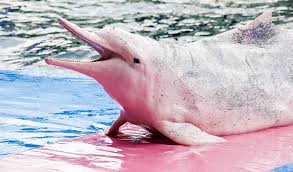Dolphins are really friendly animals. They are also very smart There are about 15 different types of species all living in different areas of the seas and some live in zoos and do performances with humans and live life to the fullest.
Different types of dolphins:
Bottlenose Dolphin: Are the ocean’s biggest show-offs! With their cool, bottlenose snouts and toothy grins, they’re the stars of every beach trip. But don’t be fooled by their smiles, these guys are super smart! They can even recognize themselves in the mirror, which is pretty impressive for an ocean acrobat. Known for their intelligence, playfulness, and friendly nature, bottlenose dolphins have a gentle demeanor and curiosity that make them approachable in the wild. If you ever get the chance, swimming with dolphins can be a truly unforgettable experience. These dolphins have been observed using creative techniques to hunt their prey, including the use of other marine animals. One particularly fascinating behavior involves using stingrays to catch octopuses.

Amazon River Dolphin: These magical creatures boast a rosy glow and the trickiest necks around. They can twist and turn like a contortionist, perfect for navigating the Amazon’s winding rivers. No need for sunglasses here, they use echolocation to see with sound waves. Unlike most dolphins, males are the pinkest! The more fights they win, the rosier they get. Sounds a bit tough on the skin, but it seems to impress the lady dolphins. Except for freshwater sharks, such as the bull shark, these dolphins are the apex predators in their river habitats. Sadly, these Amazon ambassadors are facing some threats. Pollution and habitat loss are making their home less happy. But don’t worry, people are working hard to protect them. So next time you see a dolphin show, remember the amazing pink acrobats of the Amazon.

Ganges River Dolphin: Almost blind, they navigate the murky waters using super-powered sound waves, like a living sonar system. They’re shy creatures with a unique bump on their heads, some say it looks like a friendly little smile. Unlike their playful ocean cousins, Ganges River Dolphins are solitary swimmers. They spend their days searching for yummy fish with their long, sensitive snouts. Don’t let their gentle appearance fool you, these dolphins are strong! Their powerful flippers help them zoom through the river currents with ease. Sadly, pollution and dams are making life tough for these special dolphins. They’re listed as endangered, which means they need our help. By protecting their river home, we can ensure these amazing creatures continue to grace the Ganges with their mysterious presence.

Commerson’s Dolphin: Are the fashionistas of the dolphin world. Forget boring grey, these tuxedo-wearing cuties boast a sharp black and white pattern. They’re like living pandas of the sea, earning them the nickname “piebald dolphin.” But looks aren’t everything, these clever dolphins are also excellent hunters, using their echolocation to find tasty fish in the cold waters. Unlike their bottlenose buddies, Commerson’s dolphins are a bit shy. You won’t see them leaping out of the water for cheers. But don’t worry, they’re still playful. They love to surf the waves and chase each other in speedy underwater races. Maybe they’re just practicing their runway walk for a future dolphin fashion show? Sadly, these stylish swimmers are listed as Data Deficient, meaning we don’t know enough about them. By studying these unique dolphins, we can help protect their icy homes and ensure they continue to rock their black and white with confidence.

Risso’s Dolphin: Are the badasses of the dolphin world! Forget smooth, sleek skin, these guys are covered in scars, like living battle bears of the ocean. Don’t worry, they’re not grumpy, the scars are likely to battle wounds from fights with giant squid or playful roughhousing with other dolphins. They’re the toughest-looking dolphins out there, earning them the nickname “gray grampus.” Unlike most dolphins, Risso’s dolphins are deep-sea divers. They plunge into the dark ocean depths where sunlight barely reaches, searching for yummy squid and fish. They’re like the ninjas of the water, silent and mysterious. And to get this, their bodies are specially adapted to withstand the pressure of the deep sea – pretty impressive for a scarred-up battle bear. Sadly, these deep-sea adventurers are listed as Near Threatened. We don’t know exactly why their numbers are dropping, but pollution and getting caught in fishing gear could be part of the problem. Scientists are working hard to learn more about them, so hopefully, we can help these tough guys keep cruising the deep blue.

Spinner Dolphin: Are the acrobats of the ocean. They’re famous for their amazing leaps and spins, twisting through the air like Olympic gymnasts. But these aren’t just show-offs, their spins might help them confuse predators or even stun their prey. Talk about a dazzling defense tactic. Unlike some shy dolphins, spinner dolphins are super social. They love hanging out in big groups, surfing waves together and splashing around like a giant dolphin party. You can often spot them from afar thanks to their distinctive spotted bellies and dark backs, making them look like they’re wearing fancy swimsuits. Luckily, spinner dolphins are listed as Least Concern, but that doesn’t mean they’re out of the woods. Pollution and getting tangled in fishing gear can still be a threat. So next time you see a video of a spinning dolphin, remember these amazing aerial athletes and the importance of keeping their ocean home healthy.

Spotted Dolphin: Are the polka-dotted party animals of the ocean! Covered in thousands of tiny dark spots, they have a unique, speckled appearance that makes them stand out from the crowd. But these aren’t just fashionistas, they’re also super social dolphins, often forming large pods that travel and hunt together. Unlike their acrobatic cousins, spotted dolphins are more about teamwork. They use echolocation to work together, herding fish into tight balls for an easier catch. It’s like a living underwater net, ensuring there’s enough fish to go around for the whole party. They’re also known for being curious and playful, often approaching boats to check things out. Thankfully, spotted dolphins are listed as Least Concern. But pollution and habitat loss are still threats. By protecting their ocean homes and fishing responsibly, we can ensure these polka-dotted party animals continue to thrive in the big blue.

Striped Dolphin: Are the living candy canes of the ocean. Forget boring grey, these speedy swimmers boast a cool pattern of blue and yellow stripes along their sides. They’re like living beach towels come to life, making them a splash of color in the vast blue. But these dazzling dolphins aren’t just pretty faces, they’re also super fast and energetic, known for leaping high out of the water and racing alongside boats. Unlike some solitary dolphins, striped dolphins are all about family. They travel in tight-knit groups, often with mothers and calves swimming close together. They’re also chatterboxes of the sea, using whistles and clicks to communicate with each other. Maybe they’re gossiping about the latest fish or planning their next high-speed adventure. Luckily, striped dolphins are listed as Least Concern. But pollution and getting caught in fishing gear can still be a threat. So next time you see a flash of blue and yellow in the waves, remember these dazzling, social dolphins and the importance of keeping their ocean home healthy.

Hector’s Dolphin: Are the little cuties of the dolphin world. The smallest dolphin species, they’re about the size of a large human and have a single, rounded fin that looks like a Mickey Mouse ear. Don’t let their small size fool you, they’re full of personality. They’re known for being playful and curious, often approaching boats to check things out with their big, dark eyes. Unlike some dolphins that travel long distances, Hector’s dolphins are homebodies. They stick close to the shallow waters around New Zealand, which makes them especially vulnerable to threats. Pollution and getting tangled in fishing gear are big dangers for these little guys. But don’t worry, people are working hard to protect them, creating special zones to keep them safe. Sadly, Hector’s dolphins are listed as Critically Endangered, which means their numbers are very low. By protecting their coastal homes and fishing responsibly, we can help these adorable Mickey-finned dolphins thrive once again.

Peale’s Dolphin: Are the life of the party in the coastal waters of southern South America. With their sleek gray bodies and cheeky white bellies, they sport a cool dark stripe that runs from their flippers to their tails. These dolphins grow up to 7.5 feet (2.3 meters) long. They are known for their energetic behavior, often seen leaping out of the water and surfing the waves. Usually found in small groups, their playful antics make them a favorite among wildlife lovers. The endangerment rating for Peale’s Dolphin is data deficient according to the IUCN Red List. This means that there is not enough information to assess the conservation status of the species. However, there are some threats to Peale’s dolphins, such as entanglement in fishing gear and pollution.

Atlantic Humpback Dolphin: Are the ocean’s gentle giants. Known for the distinctive hump behind their dorsal fin, they cruise the coastal waters of West Africa. These shy creatures are a bit solitary compared to other dolphins, but they still enjoy hanging out in small groups. They’re like the introverts of the dolphin world, preferring peaceful swims and fish hunts to wild acrobatics. Atlantic humpback dolphins are built for smooth cruising. Their stocky bodies and small fins help them navigate the shallow waters they call home. They may not be leaping out of the water, but they’re still graceful swimmers. Their unique pink undersides can sometimes be glimpsed as they glide through the waves, adding a touch of color to the ocean blue. Sadly, Atlantic humpback dolphins are listed as Vulnerable. Habitat loss and getting caught in fishing gear are major threats. Conservation efforts are underway to protect these gentle giants. By supporting these initiatives, we can help ensure these humpbacked beauties continue to grace the waters of West Africa for years to come.

Indo-Pacific Humpback Dolphin: Is like the ocean’s wise old grandpa. With a distinctive hump behind their dorsal fin, they cruise the warm waters of the Indo-Pacific region. Unlike their Atlantic cousins, Indo-Pacific humpback dolphins are more social, sometimes forming small pods for fishing and exploring. They’re like the experienced divers of the dolphin world, leading the way with their calm demeanor. These humpbacked dolphins might not be the flashiest acrobats, but they’re clever hunters. They use echolocation to find tasty reef fish hiding in the coral reefs and murky waters. Their unique coloration also helps them blend in, with a grayish back that fades to white on the belly. It’s like built-in camouflage for exploring the nooks and crannies of the reef. Although listed as Near Threatened, Indo-Pacific humpback dolphins still face challenges. Pollution and habitat loss threaten their coral reef homes. By protecting these underwater ecosystems and supporting sustainable fishing practices, we can ensure these wise old dolphins continue to navigate the Indo-Pacific for generations to come.

Tucuxi: Is Amazon’s social butterfly. Unlike the loner dolphins, tucuxi dolphins are super social creatures, forming giant pods of up to 100 individuals. They’re the ultimate party animals of the river, swimming, splashing, and playing together. Their muted blue-grey bodies and pink or grey bellies make them easy to spot as they zoom through the Amazon’s murky waters. Don’t let their playful side fool you, tucuxi dolphins are also skilled hunters. They use echolocation like a built-in sonar system to find tasty fish hiding in the rivers. Their long, slender beaks are perfect for snatching up their prey, making them efficient fish-catching machines. And get this, they’re even known to team up with other river dolphins for hunting adventures, talk about teamwork. Sadly, these social butterflies are listed as Data Deficient. We need to learn more about them to ensure their survival. Pollution and habitat loss from dams threaten Amazon’s delicate ecosystem. By protecting their river home and supporting sustainable practices, we can help these playful dolphins continue to party in the Amazon for years to come.

: Are the deep-sea dancers of the ocean! Found in tropical and temperate waters worldwide, these stocky dolphins are masters of the mysterious depths. Unlike acrobatic dolphins that leap and spin, Fraser’s dolphins are more subtle performers. They glide gracefully through the water, their dark backs and light undersides flashing like silver coins in the dim sunlight. Fraser’s dolphins are social creatures, but their parties are a bit more intimate. They usually travel in pods of 10 to 100 individuals, but some reports claim sightings of mega-parties with up to 1,000 dolphins. Imagine the underwater spectacle! They’re also known for their unique way of communicating, using clicks and whistles that sound almost like whistles from a faraway flute. Unfortunately, Fraser’s dolphins are listed as Data Deficient. Since they spend most of their time in the deep sea, they’re not as well-studied as other dolphin species. Threats like getting caught in fishing gear and pollution are a concern. By supporting research and sustainable fishing practices, we can help these deep-sea dancers continue their graceful waltzes in the ocean depths.

Hourglass Dolphin: Lives up to its name. These cool customers have a distinctive hourglass marking on their flanks, like a natural tattoo. Unlike their playful cousins who love to jump and splash, hourglass dolphins are a bit more reserved. They prefer the cool, temperate waters of the Southern Hemisphere, gliding gracefully through the currents. Don’t let their shy demeanor fool you, hourglass dolphins are still social creatures. They often travel in small pods of 10 to 50 individuals, working together to find food. They use their echolocation skills like a built-in sonar system, sending out clicks and listening for echoes to locate tasty fish and squid hiding in the deep. It’s like a living underwater treasure hunt. Sadly, hourglass dolphins are listed as Data Deficient. Scientists are still learning about their populations and behavior. Pollution and getting caught in fishing gear are potential threats to these sleek, hourglasses beauties. By supporting research and sustainable fishing practices, we can help ensure these mysterious dolphins continue to grace the Southern Hemisphere waters for years to come.

In my opinion the Hourglass dolphin is the prettiest dolphin out there they are sweet and are really smart, well they all are but I think the Hourglass Dolphin is the best.






































